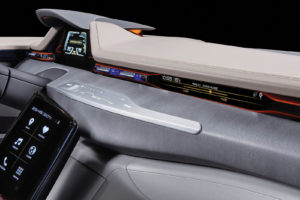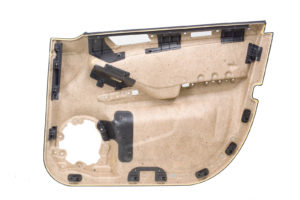
Trends reflect a global interest in natural fibers and ethical practices.
The smart and advanced textile industries, while broadly in agreement on the need to be more sustainable, are in less accord when deciding how to address the issue. Cultural and local differences can on one level exacerbate the difficulty in reaching a consensus, but they can also offer an opportunity for fostering initiatives that start small but could develop into a template for the global community.
Today Europe, tomorrow the world
In 1998, two Dutchmen, Adriaan Beukers and Ed van Hinte, published a book titled Lightness: The Inevitable Renaissance of Minimum Energy Structures. Beukers was then a professor of composite structures at TU Delft, and the book expounded on the environmental, social and design value of lightweight structures for engineering, building, transport and other applications.
The seminal book has gone on to inspire much of the thinking around sustainability and the circular economy. In 2000, the European Union issued a directive on end-of-life vehicles and the world looked from metal to textiles—and to composites in particular. A 2016 McKinsey report, “Disruptive Trends that Will Transform the Auto Industry,” anticipated that “In 2030, the share of electrified vehicles could range from 10 percent to 50 percent of new-vehicle sales.”
Gas costs, coupled with greater efficiencies and the availability of alternative energy sources, are making electric vehicles more attractive to the consumer. Vehicle weight is coming under the microscope more than ever, with textiles—composites and nonwovens, in particular—playing an important role in achieving more sustainable vehicles. The consumers of alternative energy vehicles are generally more environmentally focused than the owners of gas-fueled cars. Sustainability is a key driver in their purchasing decisions.
On October 25, 2017, the European Composites Industry Association (EuCIA) held a seminar on “Lightweight, Durable and Sustainable Composites.” While durability, strength-to-weight ratio and low fuel consumption are promoted by the industry globally, the seminar highlighted the next stage: “Sustainability as a key driver for the use of composites, and the need for life-cycle assessment (LCA) methods that provide reliable, reproducible results.”
In Elkhart, Ind., FlexForm Technologies has been producing nonwoven natural fiber mats since 1999 for a number of applications that include automotive uses. The company’s products are used in car door panels, seat backs, cab liners and flooring for American and international automotive and truck manufacturers.
The company uses kenaf stalks, which they see as comparable to glass or carbon fiber in strength but much less toxic for workers handling the chemicals associated with these materials. The environmental benefits are many. “Kenaf grows fully in seven months, tolerates drought and does not require extensive herbicides,” the company says. “It grows in regions where cotton and tobacco thrive.” The downside is a higher cost for the materials, which needs to be passed on to the consumer.
Global to local
The World Ethical Apparel Roundtable (WEAR) 2017 conference held in Toronto, Canada, highlighted the breadth of issues around sustainability. Textiles were a starting point, but three additional panels discussed the topics of waste and the circular economy, labor and water. The complexity in addressing these issues is something that all advanced textile industries face, not just the apparel industry.
As advanced and smart textiles look toward incorporating more natural fibers, the subject of animal husbandry must be considered. The issue of mulesed sheep can either be a problem or an important marketing tool. Mulesing is the practice of removing a strip of wool-bearing skin from the hindquarters of the sheep. It is a cruel and unnecessary practice primarily carried out in Australia, the main source of luxurious merino wool.
Publicity around the subject has created greater awareness among consumers, who are now demanding non-mulesed wool and are prepared to pay a premium for it. The result is increased transparency in the wool industry, providing a model for other parts of the textile industry as it moves toward a more transparent and accountable supply chain.
The food and beverage industry has an established history of accountability with labeling, such as Fair Trade and Single Origin, now a common sight on products from coffee to chocolate. A Tasmanian merino wool farmer and menswear designer M.J. Bale are working together to produce a collection of “single origin” men’s suits using non-mulesed wool from Simon Cameron’s farm. The superfine wool is baled and sent to Italy to be woven into a suiting fabric, then shipped to Japan to be handmade by tailors into suits, and finally sold online and in stores in Australia.
M.J. Bale pays an additional premium to the wool producer that’s applied to maintaining sustainable farming practices, such as preserving native grasses. Weaving the fabric and making the suits locally would reduce the carbon footprint and shipping costs, but without a large pool of workers who possess these skills in the country, the designer has limited choices—for the moment, at least.
British company Finisterre is bringing merino wool into a more technical product that is aimed at surfers. “As surfers, merino is our go-to because it is moisture-wicking and incredibly soft and warm … Climbers, runners, cyclists, hikers alike use our base layers, thanks to its antibacterial and temperature-regulating properties,” company literature says.
Like a growing number of labels wanting to avoid customer concerns on mulesing, Finisterre is sourcing its non-mulesed wool from New Zealand, where it is fully traceable. The processing and knitting is carried out in Europe by eco-label certified spinners.
From the point of view of recycling, using a single material in a product is the ideal. But this practice has to be balanced against other issues such as longevity, so 20 percent polyamide is blended with the wool to help prevent twisting and ladders forming. Bringing additional performance capabilities to natural fibers is part of a current trend in sportswear that is in part sustainability driven but also looks to the consumer attraction to heritage.
It is unlikely that the consumer is going to demand organic composites in automobiles any time soon; however, the move toward greater integration of natural fibers with high-performance fibers is already happening in applications from military apparel to truck bodies. This brings new opportunity for growth, but also highlights the need to address a whole suite of additional sustainable and ethical criteria that are new to a largely synthetic-focused industry.
Marie O’Mahony is an industry consultant, a member of the Canadian intelliWEAR Leadership Council, and the author of several books on advanced and smart textiles published by Thames and Hudson.
 FlexForm manufactures nonwoven natural fiber composite mats and panel products that are strong, lightweight, moldable and recyclable. These composite materials serve the needs of many industries including automotive, office interiors, aircraft, recreational vehicles, truck, commercial vehicles and packaging. The lightweight automotive panel increases fuel efficiency, reduces shipping and handling, and can be recycled at end of use. Photo: FlexForm Technologies.
FlexForm manufactures nonwoven natural fiber composite mats and panel products that are strong, lightweight, moldable and recyclable. These composite materials serve the needs of many industries including automotive, office interiors, aircraft, recreational vehicles, truck, commercial vehicles and packaging. The lightweight automotive panel increases fuel efficiency, reduces shipping and handling, and can be recycled at end of use. Photo: FlexForm Technologies.
 TEXTILES.ORG
TEXTILES.ORG


